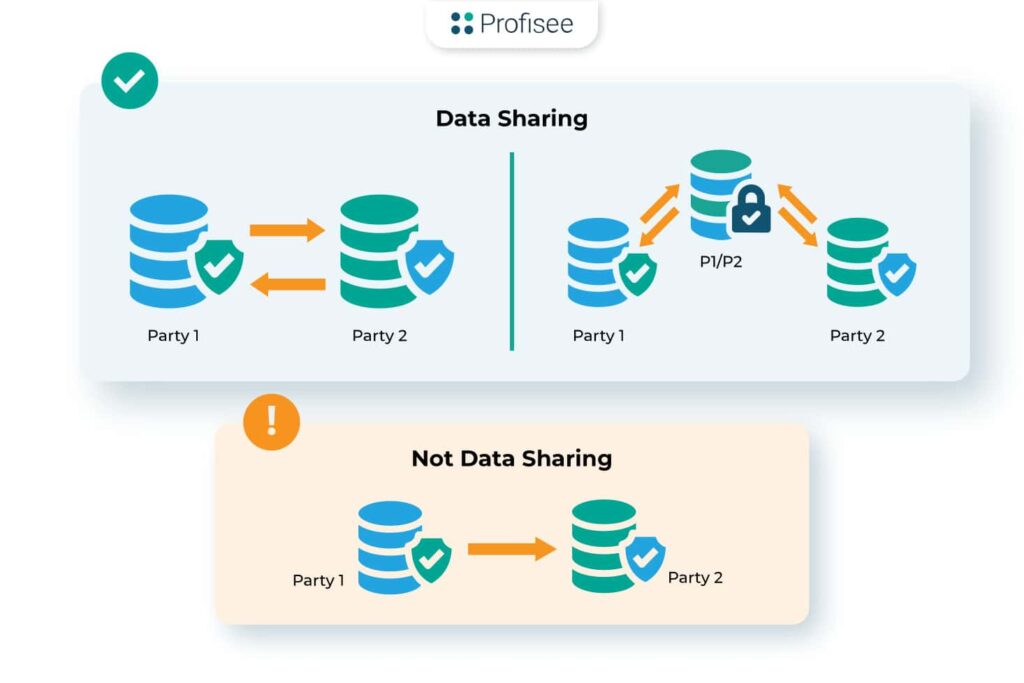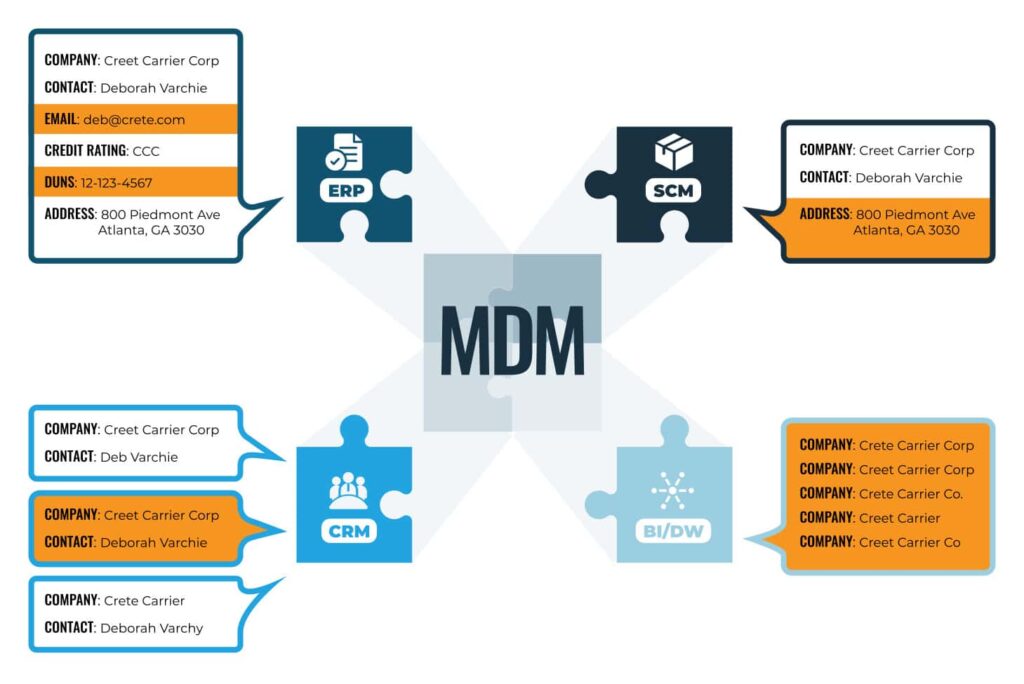Table of Contents
- What is a Data Silo?
- Example of a Data Silo
- Impact of Data/Information Silos
- How Do Data/Information Silos Occur?
- How to Identify Data Silos
- How to Break Down and Eliminate Data Silos
- Why Are Data Silos Problematic?
- Make the Most of Your Data with Master Data Management
- Were Data Silos Always a Problem?
- Breaking Down Data Silos is Only the Beginning
Updated: February 25, 2025
Data silos are isolated stores of data that arise organically across different departments, lines of business or software systems. As different teams generate, store and manage data, they develop their own systems and databases — usually without communicating with each other to make sure the data is accessible across the organization.
What is a Data Silo?
A data silo is a repository of data that is disconnected from or inaccessible by other parts of the enterprise. Data silos can either be organizational — where various departments or lines of business have their own operational or analytical use cases — or be physically separated in disparate systems that may be inaccessible to other groups.
Data silos can be created intentionally — often for cybersecurity or compliance reasons — or they can arise organically. While having multiple data silos is not ideal for organizations looking to make the most of their data, data silos are sometimes necessary and are usually created for a good reason. That said, data driven organizations should aim to reduce the number of data silos as much as possible so they can get more out of their data, like the ability to derive better business insights, identify cross-sell and upsell opportunities, optimize relationships with vendors and more.
Example of a Data Silo
Suppose you work for a regional healthcare organization that has just embarked on a massive digital transformation initiative. As part of this initiative, your team has been tasked with helping the IT department build a self-service portal where patients can log in to view a list of all your healthcare providers and locations, check to see if their insurance is accepted and manage appointments.
Up until now, this process has been entirely manual, with office staff using spreadsheets consisting of information cobbled together from various electronic health record (EHR), credentialing and medical billing systems to assist patients. Every one of these disconnected systems where data is stored represents a data silo.
This is a problem because these systems most likely contain duplicated data that is inconsistent, inaccurate, incomplete or out-of-date across systems. For example, a doctor who transferred from one location to another might have two separate records in two different EHR systems with both records indicating that the doctor is a provider at both locations when they are, in fact, not.

Accelerate Microsoft Fabric Success
Impact of Data/Information Silos
- Isolation. As mentioned above, siloed data does not communicate with other data repositories. This prevents data from being integrated and properly governed, ultimately hindering collaboration and limiting the insights you can derive from data analytics.
- Poor data quality. Data governance does not work properly when data is siloed. This often leads to issues with data quality, like inconsistent and outdated data.
- Security and compliance risks. Without proper data governance, organizations are at greater risk of security and compliance issues. For example, siloed customer credit card data could accidentally be stored in a plain text format when it should be encrypted, or sensitive patient health information could be accessible by people other than healthcare providers.
- Duplication. Because siloed data is not integrated with other data repositories, it’s easy for the same data to be stored in multiple different places. This is called data duplication, and it can have harmful effects on revenue, efficiency and margin.
- Inefficiency. Not only does siloed data lead to data duplication — it also causes inefficient business processes. For example, to analyze certain data types together, a data analyst might have to go through the time-consuming process of extracting, loading and transferring some data from one database into another when it should have been integrated all along. This not only wastes time, but also increases the risk of human error, potentially further harming data quality.
How Do Data/Information Silos Occur?
If organizations aren’t careful, data silos can arise in a few different ways.
System Lock-In
Data gets stuck in the system where it’s originally captured or stored — such as in a point-of-sale (POS) system or a customer relationship management (CRM) system — either because it’s technologically infeasible, the organization lacks the staff or skills to do otherwise or because it doesn’t occur to teams to operate differently.
Inaccessibility
BI and analytics teams perform data integration to combine isolated data sources, but the views or data products they generate are not easily accessible by end business users or across different departments (sometimes called information silos).
Poor Data Interoperability
Access to the data itself is blocked for data teams, sometimes due to data security protocols or permissions, such as those that might exist to protect personal information.
Company Culture Challenges
Company culture doesn’t promote cross-departmental collaboration — a problem especially common among larger organizations with more top-down, hierarchical organizational structures.
As you can probably tell, there are some common themes at play here. Technology might be seen as the biggest hindrance to breaking down data silos, but — while it certainly is an issue in many cases — data silos often begin with people.
Working to build a flatter organizational structure or a more collaborative work environment can do wonders to reduce silos and get more value out of your data.
How to Identify Data Silos
It’s not uncommon for people to first become aware of data silos when they discover duplicated or inconsistent data — whether they find five different records for the same customer when trying to determine customer lifetime value or three different records for the same vendor when creating a new purchase order. Outside of situations where the existence of data silos is documented (such as those created for security, privacy or compliance purposes), most people stumble upon data silos. Their existence often goes unnoticed until they start causing problems.
This works well enough for improving data quality for individual projects, but it does not scale when it comes to large initiatives like data centralization projects. For these, it’s a good idea to embark on a data discovery initiative to identify and document where data lives across your organization. Data discoveries will of course vary drastically depending on the size of an organization, the number of business units it contains and what kind of data needs to be centralized, but a discovery usually starts with surveying teams to uncover where they store the data they need to perform their jobs.
Once data silos have been identified, you can begin working on breaking down and eliminating them.
How to Break Down and Eliminate Data Silos
Breaking down data/information silos is not a quick, one-and-done task. It’s an ongoing, strategic process that requires effective data management. There needs to be an ultimate goal in place before proceeding since this involves managing and maintaining all your most critical data.
Although the ultimate goal for your organization is to boost performance, efficiency and productivity, the way to tactically eliminate silos is to harmonize your enterprise data across multiple domains.
For your data to remain accurate, consistent and reliable, it must communicate with each and every system. This can’t be done unless the data is standardized, and policies or procedures are implemented with an established data governance framework.
Adopt Data Governance
Data governance puts your data policies and standards into action and creates an enterprise-wide understanding of your data management practices. It forms the backbone of your core data and defines how it’s accessed, entered and utilized moving forward.
The framework also establishes permissions for the data environment, allowing for a hierarchical structure. This includes data ownership, accessibility, shareability, security and integration guidelines. Data governance is an effective way to start the process.

Foster a Data-Driven Culture
While it is absolutely essential to establish a governance framework and implement integrative solutions that serve your data and business needs, it falls on leadership to foster a collaborative, data-driven culture within the organization. This requires regular communication across departments and cross-functional initiatives that allow for data sharing. If the executive team promotes data accessibility, the rest of the business will follow.
Maintaining a data-driven culture is accomplished by monitoring your data standards and integrations while anticipating and preventing potential silos along the way.
Why Are Data Silos Problematic?
Ideally, data from different sources should be integrated for analysis so that analytics leaders can get a better sense of the full story told by their enterprise data. Plain and simple, data silos prevent this from happening and hold organizations back from getting the most value from their data.
Let’s break that down a bit more and look at some of the specific ways data silos can hold your organization back.
1. Data Silos Lead to Duplicate Efforts
Breaking up and siloing data within the organization often leads to the duplication of efforts and entries. Different teams or departments oversee their own unique data repositories, so information is typically recorded in multiple data sources. This adds unnecessary steps to various data analysis or reporting processes, wasting time, effort and resources.
2. Data Silos Harm Collaboration and Communication
Siloing your enterprise’s core data among each team or department is like isolating each of your team members and putting them in separate, soundproof rooms with no phone or internet connection. Communication is impossible and they can’t work together to achieve a common goal.
That’s exactly what happens with data silos. Because the data itself can’t communicate with other systems and harmonize throughout the entire business, neither can the employees. This slows down projects and stifles innovation. When you remove a company’s ability to access and share crucial data, you hinder teamwork and overall productivity.
3. Data Silos Lead to Inconsistent Information
If the same or similar data is being entered in different ways with different standards across separate systems, there are bound to be inconsistencies and inaccuracies. Because the data is not uniformly standardized, data integrity and consistency are compromised.
This leads to organizations leveraging poor-quality data, creating confusion and doubt as to whether the foundational data can even be trusted. If the data is inconsistent or inaccurate, your enterprise suffers from discrepancies in reporting, analysis and decision-making.
4. Data Silos Can Cause Missed Opportunities
It’s difficult to stay informed or updated on anything when you don’t have a comprehensive view of all the moving parts. The same principle applies to siloed data sources. If a business can’t see or access all its crucial data components, then it can’t uncover valuable insights that may lead to opportunities.
Isolated data makes it difficult to anticipate market trends and identify major correlations across the business. Strategic initiatives suffer tremendously when insights remain hidden and data isn’t leveraged.
5. Data Silos Lead to Misallocated Resources
Fragmented data creates a fragmented view of your resources. A lack of full visibility into an organization’s resource availability and utilization leads to misallocated resources and operational inefficiencies.
Whether it’s personnel, equipment, budget or something else, over- or under-allocating valuable resources not only decreases productivity but also causes enterprise-wide imbalances that could affect the organization.
Make the Most of Your Data with Master Data Management
Making the most of your data doesn’t end with eliminating data silos — it also requires a trusted data environment built on high-quality master data.
A solid master data management (MDM) solution is essential for ensuring clean, accurate and trustworthy data across multiple systems and processes within an organization. Executing a successful implementation requires careful planning and an effective MDM strategy.

Here are some helpful tips for improving organizational productivity with MDM.
1. Define Goals and Objectives
Before you deploy an MDM solution, identify specific areas for improvement and determine your desired business outcomes. You need achievable business goals before launching a major data solution.
This can include reducing duplicate invoices thanks to deduplicated data or reducing the time to close quarterly financials because analysts no longer have to manually clean the data every time — to name a few. But before you start your journey, your organization needs to agree on a destination.
2. Align Goals to Data Quality Issues
As you prioritize your efforts, you need to identify the critical data domains that are most important to your organization for growing the business. These are the data elements to master and manage first.
During your first MDM initiative, you need to justify its value to the rest of the organization. Prove to your investors and shareholders that they made the right call. Focus your MDM efforts where you need them most and manage your scope based on each domain’s strategic importance.
3. Implement Data Profiling
Before finally launching that strategic MDM initiative, your data needs a diagnosis. Perform data profiling to identify any duplicates, inconsistencies, silos or missing values that stand in your way. Knowing the current state of your data quality shines a light on where MDM can best benefit your organization.
From there, you can develop the necessary data-cleansing tools and processes for addressing these issues to deliver the accurate and reliable data required for stronger performance and increased productivity.
Were Data Silos Always a Problem?
Data silos are certainly a problem when it comes to executing on strategic initiatives like ERP migration, procurement optimization or Customer 360, but data silos in and of themselves are not necessarily a bad thing. In fact, in some cases, they might even be a good idea, at least for some time.
Data silos tend to arise spontaneously and may not become an issue until the organization grows larger. At the time they’re created, it might make sense to store data this way for any number of reasons:
- Other systems or organizations simply don’t require access to it
- It’s not feasible to store the data another way
- Teams lack the technical know-how to make the data interoperable
- It doesn’t occur to teams to do otherwise
In other cases, data may be intentionally siloed due to regulatory requirements, security concerns or something else. The medical billing department at a healthcare organization, for example, does not need unfettered access to patients’ protected health information (PHI). Not only does this kind of data not warrant access by other teams or departments outside of care teams, but making it accessible in such a way is most likely a violation of HIPAA or similar regulations that could land an organization in legal hot water with regulatory bodies.
Breaking Down Data Silos is Only the Beginning
Breaking down data silos is a crucial component of an effective MDM program. It provides your organization with harmonized data systems and delivers a centralized hub for trusted, high-quality data. But silos are only the tip of the iceberg!
Read our full guide on developing an MDM strategy to learn more about how to build a unified data environment through master data management.

Forrest Brown
Forrest Brown is the Content Marketing Manager at Profisee and has been writing about B2B tech for eight years, spanning software categories like project management, enterprise resource planning (ERP) and now master data management (MDM). When he's not at work, Forrest enjoys playing music, writing and exploring the Atlanta food scene.











